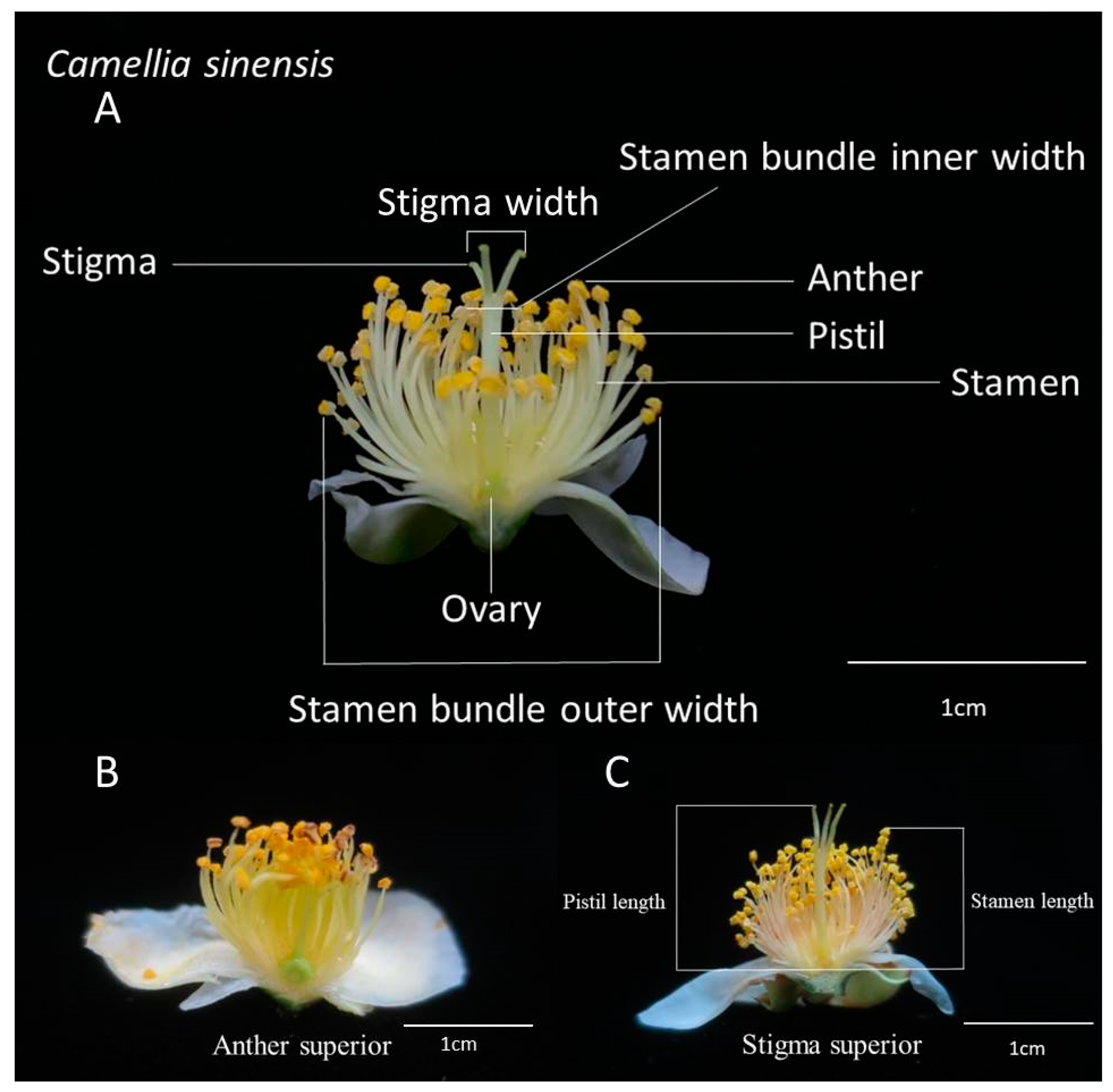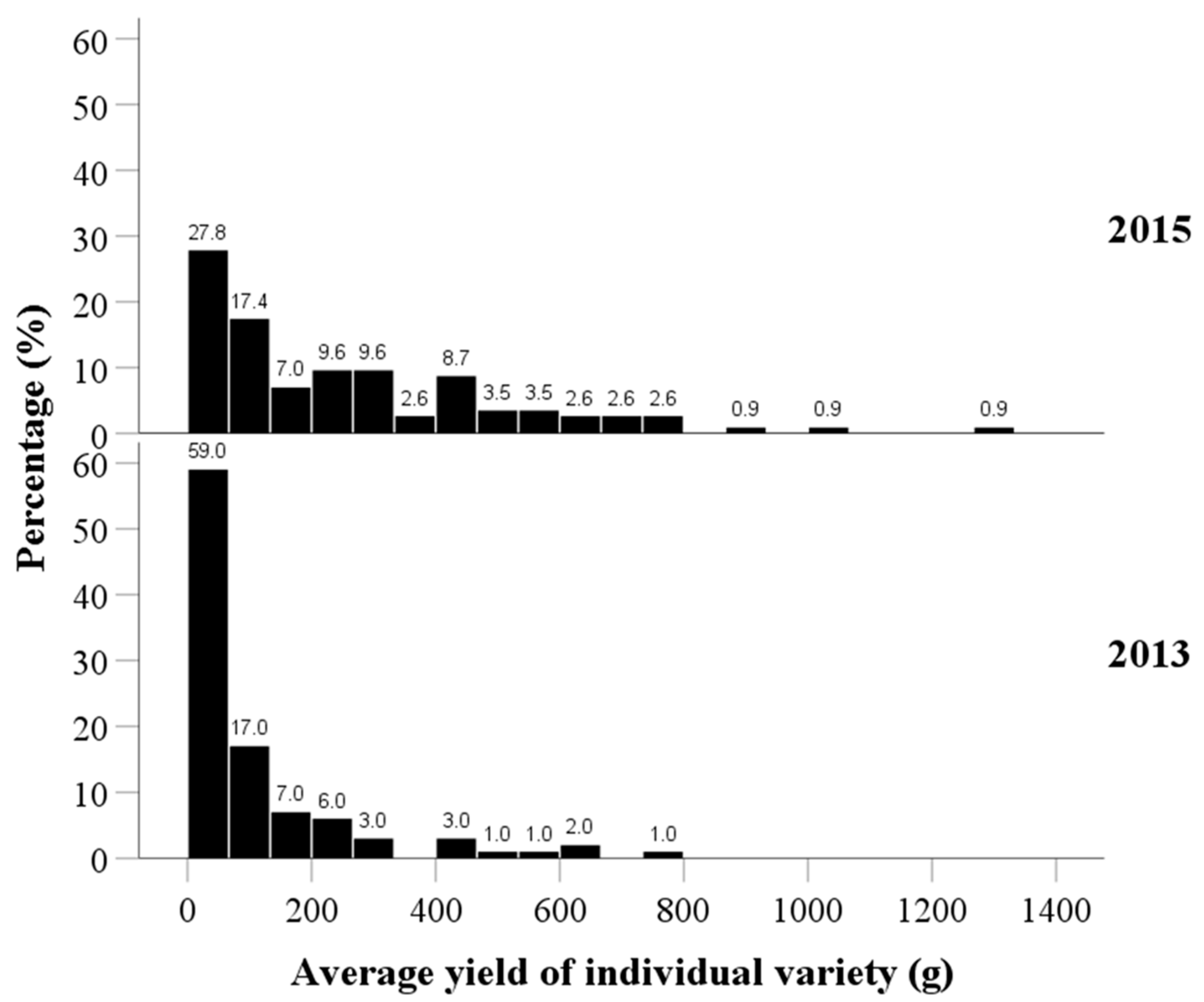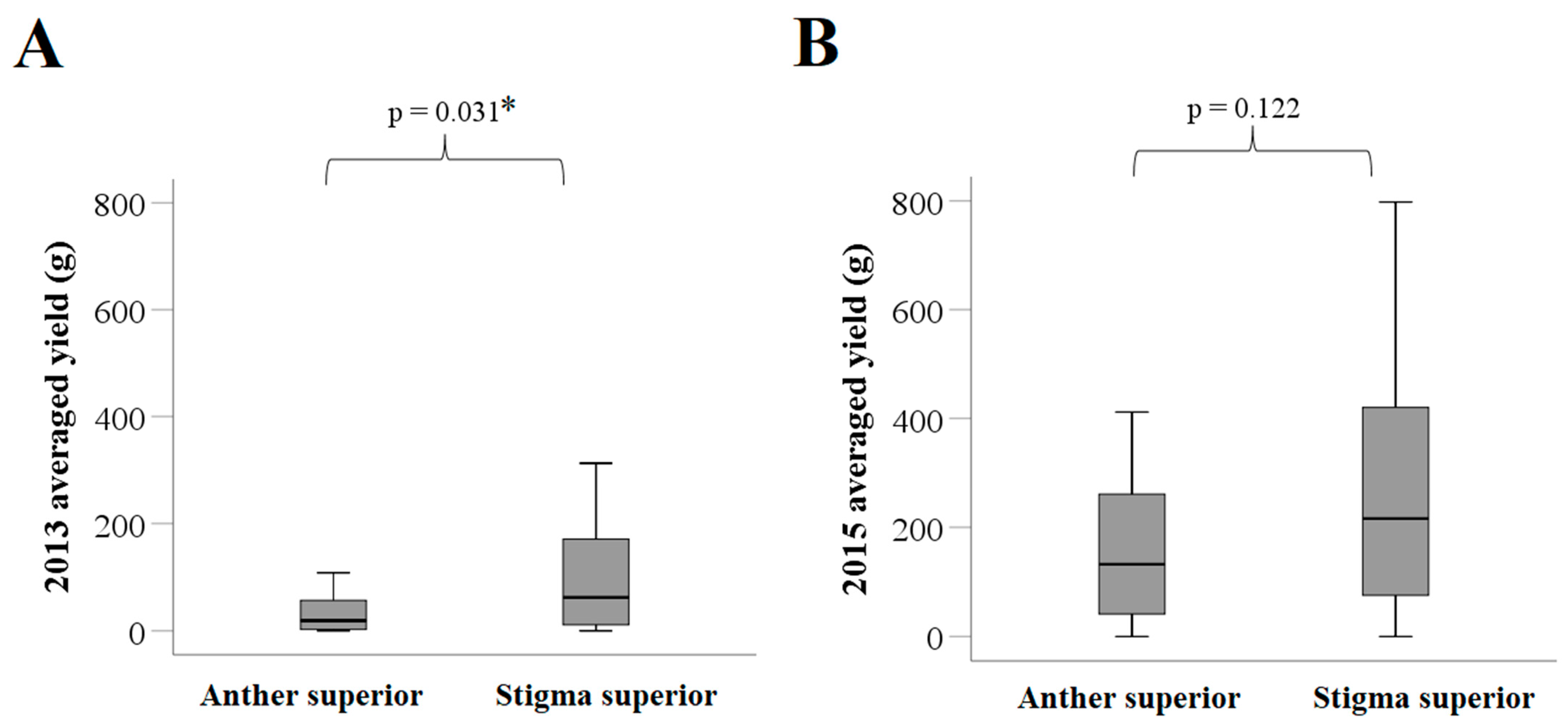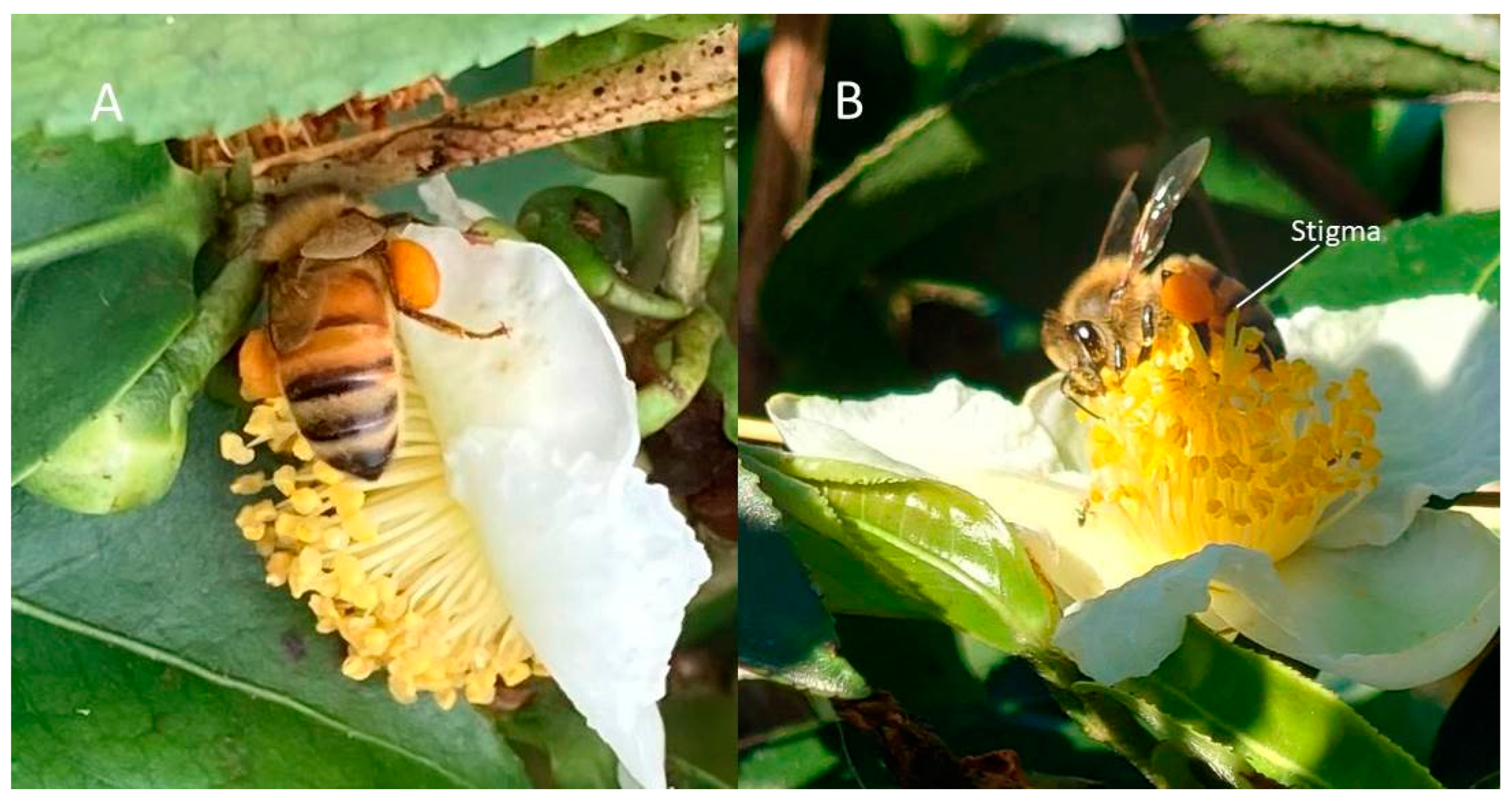Relationship between Flower Phenotypic Traits and Fruit Yields in Tea (Camellia sinensis L.) Varieties
Abstract
:1. Background
2. Methods
2.1. Plant Materials
2.2. Flower Morphology
2.3. Pollen Viability Test of Tea Varieties
2.4. Fruit Yield
2.5. Statistical Analysis
3. Results
3.1. Evaluation for the Homogeneity of Phenotypic Traits within Species
3.2. Differences in Phenotypic Traits between Groups
3.3. Pollen Viability
3.4. Yield Distribution of Test Tea Varieties within Two Years
3.5. Distribution of Fruit Yield between the Anther and Stigma Superior Groups
3.6. Monotonic Correlations between Phenotypic Traits and Yield
3.7. Effects of Phenotypic Traits on Yield in 2013 and 2015
4. Discussion
5. Conclusions
Author Contributions
Funding
Institutional Review Board Statement
Informed Consent Statement
Data Availability Statement
Acknowledgments
Conflicts of Interest
Abbreviations
| LSI | Late-acting self-incompatibility |
| ICC | Intraclass correlation coefficient |
| IQR | Interquartile range |
References
- Taniguchi, F.; Kimura, K.; Saba, T.; Ogino, A.; Yamaguchi, S.; Tanaka, J. Worldwide core collections of tea (Camellia sinensis) based on SSR markers. Tree Genet. Genomes 2014, 10, 1555–1565. [Google Scholar] [CrossRef]
- Chiu, T.F. Tea production and research in Taiwan. In Recent Development in Tea Production; Chiu, T.F., Wang, C.H., Eds.; Taiwan Tea Experiment Station: Taoyuan, Taiwan, 1988; pp. 121–129. [Google Scholar]
- Jun, I.M.; Lin, M.L. Present status of tea industry in Taiwan. Taiwan Tea Res. Bull. 1997, 16, 87–97. [Google Scholar]
- Council of Agriculture. Agricultural Statistics Yearbook in 2020; Council of Agriculture, Executive Yuan: Taipei, Taiwan, 2021; p. 40. [Google Scholar]
- Hu, C.Y. Studies on the Variations in Leaf Characters and DNA Sequences of Tea Germplasm in Taiwan. Master’s Thesis, National Taiwan University, Taipei, Taiwan, 2004. [Google Scholar]
- Hu, C.Y.; Tsai, Y.Z.; Lin, S.F. Using ISSR DNA markers to evaluate genetic diversity of tea germplasm in Taiwan. J. Agric. Assoc. China 2005, 6, 463–480. [Google Scholar]
- Hu, C.Y.; Tsai, Y.Z.; Lin, S.F. Evaluating the feasibility of molecular identification for made tea varieties. J. Agric. Assoc. China 2006, 7, 499–510. [Google Scholar]
- Hu, C.Y.; Lin, Y.C.; Hsieh, W.T.; Tseng, Y.H.; Lin, S.F.; Tsai, Y.Z. Using EST-SSR markers to identify tea (Camellia sinensis) cultivars in Taiwan. Taiwan Tea Res. Bull. 2011, 30, 9–22. [Google Scholar]
- Sanui, H. Tea breeding in Taiwan. In Tea Breeding in Taiwan during Japanese Occupation Period; Shyu, Y.S., Ed.; Tea Research and Extension Station: Taoyaun, Taiwan, 2011; pp. 4–51. [Google Scholar]
- Shyu, Y.S.; Juan, I.M. Retrospect of tea breeding in Taiwan. Taiwan Tea Res. Bull. 1993, 12, 1–17. [Google Scholar]
- Tsai, H.T.; Tsai, I.C.; Liaw, W.R.; Chang, C.K.; Wang, Y.W. Study on the genetic diversity among the selected Taiwan tea cultivars/lines using AFLP and RAPD markers. Taiwan Tea Res. Bull. 2003, 22, 17–32. [Google Scholar]
- Piyasundara, J.H.N.; Wickramasinghe, I.P.; Gunesekara, M.T.K.; Wijeratne, M.A.; Perera, S.A.C.N.; Ranathunga, M.A.B.; Mudalige, A.K. Reproductive phenology of tea (Camellia sinensis (L.) O. Kuntze) cultivars in Sri Lanka. Trop. Agric. Res. 2018, 29, 288–301. [Google Scholar] [CrossRef] [Green Version]
- Su, M.H.; Shih, M.C.; Lin, K.H. Chemical composition of seed oils in native Taiwanese Camellia species. Food Chem. 2014, 156, 369–373. [Google Scholar] [CrossRef]
- Hieh, W.M. The industry development process of Camellia oil in Taiwan. J. Agric. For. 2020, 67, 223–232. Available online: https://canr.nchu.edu.tw/upload/files/jaf/67-4-1%E8%87%BA%E7%81%A3%E8%8C%B6%E6%B2%B9%E7%94%A2%E6%A5%AD%E7%99%BC%E5%B1%95%E6%AD%B7%E7%A8%8B.pdf (accessed on 1 July 2022).
- Ariyarathna, H.A.C.K.; Gunasekare, M.T.K.; Kottawa-Arachchige, J.D.; Paskarathevan, R.; Ranaweera, K.K.; Ratnayake, M.; Kumara, J.B.D.A.P. Morpho-physiological and phenological attributes of reproductive biology of tea (Camellia sinensis (L.) O. Kuntze) in Sri Lanka. Euphytica 2011, 181, 203–215. [Google Scholar] [CrossRef]
- Ariyarathna, C.; Kottawa-Arachchi, J.; Gunasekare, M. Floral biology and breeding system of tea [Camellia sinensis L.]: Implication on the tea breeding programme. SLJ Tea Sci. 2007, 72, 31–43. Available online: https://www.researchgate.net/publication/268819279_Floral_Biology_and_Breeding_system_of_Tea_Camellia_sinensis_L_Implication_on_the_Tea_Breeding_Programme (accessed on 1 July 2022).
- Kodad, O.; Socias i Company R. Floral characterization of some self-compatible almond selections. In XIII GREMPA Meeting on Almonds and Pistachios; Options Méditerranéennes: Série A. Séminaires Méditerranéens; Oliveira, M.M., Cordeiro, V., Eds.; CIHEAM: Zaragoza, Spain, 2005; pp. 161–166. [Google Scholar]
- MartÍNez-GarcÍAP, J.; Ortega, E.; Dicenta, F. Analysis of the expression of partial self-incompatibility in almond (Prunus dulcis). J. Hortic. Sci. Biotechnol. 2011, 86, 284–290. [Google Scholar] [CrossRef]
- Bernad, D.; R. Socias i Company. Characterization of some self-compatible almonds. II. Flower phenology and morphology. HortScience 1995, 30, 321–324. [Google Scholar] [CrossRef] [Green Version]
- Barua, P.K. Classification of the tea plant. Two Bud 1963, 10, 3–11. [Google Scholar]
- Chen, X.; Hao, S.; Wang, L.; Fang, W.; Wang, Y.; Li, X. Late-acting self-incompatibility in tea plant (Camellia sinensis). Biologia 2012, 67, 347–351. [Google Scholar] [CrossRef] [Green Version]
- Kumarihami, H.M.P.C.; Eun, U.O.; Atsushi, N.; Kwan, J.S. Comparative study on cross-compatibility between Camellia sinensis var. sinensis (China type) and C. sinensis var. assamica (Assam type) tea. Afr. J. Agric. Res. 2016, 11, 1092–1101. [Google Scholar] [CrossRef] [Green Version]
- Liao, T.; Yuan, D.Y.; Zou, F.; Gao, C.; Yang, Y.; Zhang, L.; Tan, X.F. Self-sterility in Camellia oleifera may be due to the prezygotic late-acting self-incompatibility. PLoS ONE 2014, 9, e99639. [Google Scholar] [CrossRef]
- Yang, M.J. Studies on the Self-Incompatibility of Tea. Master’s Thesis, National Taiwan University, Taipei, Taiwan, 1998. [Google Scholar]
- Yang, M.J.; Chen, Y.Z. Observation of the self-incompatibility phenomenon of tea. J. Chin. Soc. Hortic. Sci. 1998, 46, 83–92. [Google Scholar]
- Zhang, C.C.; Wang, L.Y.; Wei, K.; Wu, L.Y.; Li, H.L.; Zhang, F.; Cheng, H.; Ni, D.J. Transcriptome analysis reveals self-incompatibility in the tea plant (Camellia sinensis) might be under gametophytic control. BMC Genom. 2016, 17, 359. [Google Scholar] [CrossRef] [Green Version]
- Seth, R.; Bhandawat, A.; Parmar, R.; Singh, P.; Kumar, S.; Sharma, R.K. Global transcriptional insights of pollen-pistil interactions commencing self-incompatibility and fertilization in tea [Camellia sinensis (L.) O. Kuntze]. Int. J. Mol. Sci. 2019, 20, 539. [Google Scholar] [CrossRef] [PubMed] [Green Version]
- Ma, Q.; Chen, C.; Zeng, Z.; Zou, Z.; Li, H.; Zhou, Q.; Chen, X.; Sun, K.; Li, X. Transcriptomic analysis between self- and cross-pollinated pistils of tea plants (Camellia sinensis). BMC Genom. 2018, 19, 289. [Google Scholar] [CrossRef] [PubMed] [Green Version]
- Wright, S.I.; Kalisz, S.; Slotte, T. Evolutionary consequences of self-fertilization in plants. Proc. R. Soc. B Biol. Sci. 2013, 280, 20130133. [Google Scholar] [CrossRef] [PubMed] [Green Version]
- Kottawa-Arachchi, J.D.; Ranatunga, M.A.B.; Ranaweera, K.K. Recent progress of intra-specific hybridization of tea (Camellia sinensis (L.) O. Kuntze) in Sri Lanka. SLJ Food Agric. 2019, 5, 19–26. [Google Scholar] [CrossRef] [Green Version]
- Wachira, F.N.; Kamunya, S.K. Pseudo-self-incompatibility in some tea clones (Camellia sinensis (L.) O. Kuntze). J. Hortic. Sci. Biotechnol. 2005, 80, 716–720. [Google Scholar] [CrossRef]
- Tan, L.Q.; Liu, Q.L.; Zhou, B.; Yang, C.J.; Zou, X.; Yu, Y.Y.; Wang, Y.; Hu, J.H.; Zou, Y.; Chen, S.X.; et al. Paternity analysis using SSR markers reveals that the anthocyanin-rich tea cultivar ‘Ziyan’ is self-compatible. Sci. Hortic. 2019, 245, 258–262. [Google Scholar] [CrossRef]
- Shivanna, R.K.; Mohan Ram, Y.H. Pollination biology: Contributions to fundamental and applied aspects. Current Science. 1993, 65, 226–233. Available online: https://core.ac.uk/download/pdf/291544001.pdf (accessed on 1 July 2022).
- Muoki, C.; Wachira, F.; Pathak, R.; Kamunya, S. Potential male gametophyte competition among Camellia sinensis genotypes in isolated biclonal seed orchards. Afr. Crop Sci. J. 2010, 15, 59–66. [Google Scholar] [CrossRef] [Green Version]
- Brewbaker, J.L.; Kwack, B.H. The essential role of calcium ion in pollen germination and pollen tube growth. Am. J. Bot. 1963, 50, 859–865. [Google Scholar] [CrossRef]
- Hepler, P.K.; Lovy-Wheeler, A.; McKenna, S.T.; Kunkel, J.G. Ions and pollen tube growth. In The Pollen Tube: A Cellular and Molecular Perspective; Malhó, R., Ed.; Springer: Berlin, Heidelberg, 2006; pp. 47–69. [Google Scholar]
- Peterson, R.; Slovin, J.P.; Chen, C. A simplified method for differential staining of aborted and non-aborted pollen grains. Int. J. Plant Biol. 2010, 1, 66–69. [Google Scholar] [CrossRef] [Green Version]
- Brown, W.V. A preliminary study of the staining of plant cells by tetrazolium chloride. Bull. Torrey Bot. Club 1954, 81, 127–136. [Google Scholar] [CrossRef]
- Lansac, A.R.; Sullivan, C.Y.; Johnson, B.E.; Lee, K.W. Viability and Germination of the Pollen of Sorghum [Sorghum bicolor (L.) Moench]. Ann. Bot. 1994, 74, 27–33. [Google Scholar] [CrossRef] [PubMed]
- Sulusoglu, M.; Cavusoglu, A. In vitro pollen viability and pollen germination in cherry laurel (Prunus laurocerasus L.). Sci. World J. 2014, 2014, 657123. [Google Scholar] [CrossRef] [PubMed] [Green Version]
- Mitra, B.; Kumar Shah, S.; Mishra, P. Insect Fauna associated with the tea ecosystem of North Bengal, India. Rec. Zool. Surv. India 2018, 118, 178–193. [Google Scholar] [CrossRef] [Green Version]
- Wei, W.; Wu, H.; Li, X.; Wei, X.; Lu, W.; Zheng, X. Diversity, daily activity patterns, and pollination effectiveness of the insects visiting Camellia osmantha, C. vietnamensis, and C. oleifera in South China. Insects 2019, 10, 98. [Google Scholar] [CrossRef] [Green Version]
- Altuntas, E.; Yildiz, M. Some engineering properties of shelled and kernel tea (Camellia sinensis) seeds. Afr. J. Tradit. Complement. Altern. Med. 2017, 14, 39–45. [Google Scholar] [CrossRef] [Green Version]
- George, K.O.; Wanyoko, J.K.; Kinyanjui, T.; Moseti, K.O.; Wachira, F.N. Comparative assessment of the fatty acid profiles of crude oils extracted from seeds of selected tea (Camellia sinensis L.) cultivars. Food Nutr. Sci. 2016, 7, 1–7. [Google Scholar] [CrossRef] [Green Version]
- George, K.O.; Kinyanjui, T.; Wanyoko, J.; Moseti, O.K.; Wachira, F. Extraction and analysis of tea (Camellia sinensis) seed oil from different clones in Kenya. Afr. J. Biotechnol. 2013, 12, 841–846. [Google Scholar] [CrossRef]
- George, K.O.; Moseti, K.O.O.; Wanyoko, J.K.; Kinyanjui, T.; Wachira, F.N. Quantitation of the total catechin content in oils extracted from seeds of selected tea (Camellia sinensis (L.) O. Kuntze, Theaceae) Clones by RP-HPLC. Am. J. Plant Sci. 2015, 6, 1080–1089. [Google Scholar] [CrossRef] [Green Version]
- Barooah, A.K.; Singh, S.K.; Das, B.; Sarma, R.; Patel, P.K. Tea seed oil: Physicochemical profiling. J. Plant. Crops 2020, 48, 247–251. [Google Scholar] [CrossRef]
- Koo, T.K.; Li, M.Y. A guideline of selecting and reporting intraclass correlation coefficients for reliability research. J. Chiropr. Med. 2016, 15, 155–163. [Google Scholar] [CrossRef] [PubMed] [Green Version]






| No. | Tea Varieties | ICC of Flowers | Anther vs. Stigma Position | Position Gap (mm) |
|---|---|---|---|---|
| 1 | Chun-Ho-Sheng | 0.992 | Anther superior | −0.86 |
| 2 | Han-Kou | 0.996 | Anther superior | −0.34 |
| 3 | Hsiao-Tsu-Keng | 0.992 | Anther superior | −0.49 |
| 4 | Lin-Kou-Ta-Yeh-Wu | 0.998 | Anther superior | −0.03 |
| 5 | Manipuri | 0.997 | Anther superior | −0.12 |
| 6 | Niu-Pu | 0.996 | Anther superior | −0.11 |
| 7 | Pai-Mao-Hou | 0.995 | Anther superior | −0.35 |
| 8 | Shan-Cha | 0.992 | Anther superior | −0.58 |
| 9 | Shen-Man-Chung | 0.993 | Anther superior | −0.31 |
| 10 | Sou-Pei | 0.996 | Anther superior | −1.26 |
| 11 | Ssu-Chi-Chun | 0.993 | Anther superior | −0.06 |
| 12 | Ta-Hu-Wei | 0.998 | Anther superior | −0.51 |
| 13 | TTES No. 4 | 0.992 | Anther superior | −1.56 |
| 14 | TTES No. 5 | 0.990 | Anther superior | −0.17 |
| 15 | TTES No. 8 | 0.993 | Anther superior | −0.20 |
| 16 | Yu-Chih | 0.995 | Anther superior | −0.77 |
| 17 | Hei-Mien-Tsao-Chung | 0.996 | Stigma superior | 1.61 |
| 18 | Pu-Chih-Chun | 0.993 | Stigma superior | 1.13 |
| 19 | Tao-Jen-Chung | 0.993 | Stigma superior | 0.08 |
| 20 | Assam indigenous | 0.995 | Stigma superior | 1.35 |
| 21 | Chih-Lan | 0.989 | Stigma superior | 1.10 |
| 22 | Chi-Lan | 0.986 | Stigma superior | 2.26 |
| 23 | Chi-Lung-Chin-Kuei | 0.994 | Stigma superior | 0.39 |
| 24 | Chi-Lung-Pai-Chung | 0.989 | Stigma superior | 2.30 |
| 25 | Chi-Men | 0.991 | Stigma superior | 0.15 |
| 26 | Ching-Hsin-Ta-Mou | 0.996 | Stigma superior | 1.41 |
| 27 | Ching-Hsin-Tsao-Chung | 0.992 | Stigma superior | 1.57 |
| 28 | Ching-Hsin-Wu-Lung | 0.996 | Stigma superior | 0.51 |
| 29 | Chin-Kuei | 0.991 | Stigma superior | 0.89 |
| 30 | Chu-Yeh | 0.997 | Stigma superior | 1.38 |
| 31 | Feng-Lin-Tsai | 0.995 | Stigma superior | 0.18 |
| 32 | Fu-Chou | 0.996 | Stigma superior | 0.60 |
| 33 | Han-Hsiao | 0.994 | Stigma superior | 1.24 |
| 34 | Hei-Mao-Hou | 0.989 | Stigma superior | 1.08 |
| 35 | Heng-Che-Ta-Yeh | 0.992 | Stigma superior | 1.69 |
| 36 | Hsiao-Yeh-Tieh-Kuan-Yin | 0.994 | Stigma superior | 0.36 |
| 37 | Huang-Chih | 0.994 | Stigma superior | 0.54 |
| 38 | Huang-Chin-Kuei | 0.987 | Stigma superior | 1.02 |
| 39 | Huang-Hsin-Wu-Lung | 0.995 | Stigma superior | 0.24 |
| 40 | Huang-Kan | 0.990 | Stigma superior | 0.38 |
| 41 | Hu-Nan | 0.978 | Stigma superior | 1.58 |
| 42 | Hung-Hsin-Ta-Mou | 0.994 | Stigma superior | 0.96 |
| 43 | Hung-Hsin-Wu-Lung | 0.993 | Stigma superior | 0.65 |
| 44 | Hung-Hsin-Wu-Yi | 0.997 | Stigma superior | 1.51 |
| 45 | Hung-Wei-Tsai | 0.993 | Stigma superior | 0.83 |
| 46 | Jaipuri | 0.993 | Stigma superior | 0.57 |
| 47 | Jou-Kuei | 0.989 | Stigma superior | 0.27 |
| 48 | Kan-Tsai | 0.993 | Stigma superior | 3.29 |
| 49 | Kan-Tsai (Yellow) | 0.995 | Stigma superior | 0.72 |
| 50 | Kuei-Hua | 0.994 | Stigma superior | 0.61 |
| 51 | Kyang | 0.998 | Stigma superior | 0.78 |
| 52 | Mao-Hsieh | 0.995 | Stigma superior | 0.31 |
| 53 | Mao-Tsai | 0.991 | Stigma superior | 0.41 |
| 54 | Mei-Chan | 0.990 | Stigma superior | 2.37 |
| 55 | Mien-Tien | 0.994 | Stigma superior | 1.53 |
| 56 | Niu-Shih-Wu | 0.990 | Stigma superior | 2.25 |
| 57 | Pa-Hsien | 0.995 | Stigma superior | 1.27 |
| 58 | Pai-Hsin-Wu-Lung | 0.996 | Stigma superior | 2.23 |
| 59 | Pai-Hsin-Wu-Yi | 0.995 | Stigma superior | 2.02 |
| 60 | Pai-Yeh | 0.986 | Stigma superior | 1.21 |
| 61 | Ping-Shui | 0.993 | Stigma superior | 0.18 |
| 62 | Po-Yeh | 0.989 | Stigma superior | 1.45 |
| 63 | San-Cha-Chih-Lan | 0.996 | Stigma superior | 0.27 |
| 64 | Shan | 0.996 | Stigma superior | 0.47 |
| 65 | Shih-Cha | 0.987 | Stigma superior | 0.10 |
| 66 | Shui-Hsien | 0.995 | Stigma superior | 1.79 |
| 67 | Ssu-Chi-Chun-Pien-Chung | 0.995 | Stigma superior | 0.06 |
| 68 | Ta-Chi-Ling | 0.993 | Stigma superior | 1.27 |
| 69 | Ta-Ching-Tsao-Sheng | 0.993 | Stigma superior | 1.02 |
| 70 | Ta-Mou | 0.995 | Stigma superior | 1.98 |
| 71 | Ta-Nan-Wan-Hei-Mao-Hou | 0.986 | Stigma superior | 0.75 |
| 72 | Tan-Shui-Ching-Hsin | 0.993 | Stigma superior | 0.51 |
| 73 | Ta-Teng | 0.996 | Stigma superior | 2.45 |
| 74 | Ta-Yeh-Wu-Lung | 0.995 | Stigma superior | 3.67 |
| 75 | Tieh-Kuan-Yin | 0.995 | Stigma superior | 1.01 |
| 76 | Tien-Kung | 0.992 | Stigma superior | 1.06 |
| 77 | Tsao-Chung | 0.996 | Stigma superior | 1.21 |
| 78 | TTES No. 1 | 0.990 | Stigma superior | 1.14 |
| 79 | TTES No. 10 | 0.992 | Stigma superior | 0.09 |
| 80 | TTES No. 11 | 0.991 | Stigma superior | 2.94 |
| 81 | TTES No. 12 | 0.989 | Stigma superior | 1.75 |
| 82 | TTES No. 13 | 0.993 | Stigma superior | 2.07 |
| 83 | TTES No. 14 | 0.989 | Stigma superior | 1.81 |
| 84 | TTES No. 15 | 0.996 | Stigma superior | 1.04 |
| 85 | TTES No. 16 | 0.996 | Stigma superior | 3.40 |
| 86 | TTES No. 17 | 0.988 | Stigma superior | 2.45 |
| 87 | TTES No. 19 | 0.997 | Stigma superior | 0.57 |
| 88 | TTES No. 2 | 0.996 | Stigma superior | 0.27 |
| 89 | TTES No. 20 | 0.991 | Stigma superior | 0.91 |
| 90 | TTES No. 21 | 0.990 | Stigma superior | 1.07 |
| 91 | TTES No. 3 | 0.995 | Stigma superior | 0.49 |
| 92 | TTES No. 6 | 0.991 | Stigma superior | 1.16 |
| 93 | TTES No. 7 | 0.991 | Stigma superior | 0.38 |
| 94 | TTES No. 9 | 0.987 | Stigma superior | 0.54 |
| 95 | Tu-Tsai-Keng-Pai-Mao-Hou | 0.995 | Stigma superior | 1.45 |
| 96 | Tzu-Chung | 0.995 | Stigma superior | 0.22 |
| 97 | Wan-Chung | 0.991 | Stigma superior | 1.54 |
| 98 | Wen-Shan-Chih-Lan | 0.992 | Stigma superior | 1.01 |
| 99 | Wen-Shan-Ta-Yeh-Wu | 0.995 | Stigma superior | 0.61 |
| 100 | Wu-Chin | 0.994 | Stigma superior | 0.40 |
| 101 | Wu-Ku-Tsai | 0.963 | Stigma superior | 0.15 |
| 102 | Wu-Yi | 0.995 | Stigma superior | 0.17 |
| 103 | Wu-Yi-Pien-Chung (Yellow leaves) | 0.990 | Stigma superior | 0.30 |
| 104 | Yen-Chuan | 0.993 | Stigma superior | 0.16 |
| 105 | Ying-Chih-Hung-Hsin | 0.992 | Stigma superior | 2.15 |
| 106 | Ying-Chih-Tsao-Chung | 0.990 | Stigma superior | 0.53 |
| Phenotypic Trait | Total (N = 106) | Anther Superior (Pistil Length < Stamen Length) (N = 16) | Stigma Superior (Pistil Length ≥ Stamen Length) (N = 90) | p-Value |
|---|---|---|---|---|
| Pistil length (mm) | 11.8 (10.3, 13.3) | 10.1 (9.5, 10.9) | 12.2 (11.0, 13.5) | <0.001 ** |
| Stamen length (mm) | 10.9 (10.1, 11.9) | 10.7 (10.1, 11.5) | 10.9 (10.1, 12.0) | 0.308 |
| Pistil length minus stamen length (mm) | 0.7 (0.2, 1.5) | −0.3 (−0.7, −0.1) | 1.0 (0.4, 1.5) | <0.001 ** |
| Stamen bundle inner width (mm) | 2.5 (2.1, 3.1) | 2.4 (1.8, 2.6) | 2.5 (2.2, 3.2) | 0.073 |
| Stamen bundle outer width (mm) | 15.0 (14.0, 17.0) | 14.6 (13.3, 15.6) | 15.1 (14.0, 17.1) | 0.123 |
| Stamen bundle outer width minus stamen bundle inner width (mm) | 12.4 (14.2, 11.5) | 12.3 (13.5, 11.0) | 12.5 (14.3, 11.5) | 0.215 |
| Stigma width (mm) | 3.7 (2.9, 4.9) | 3.0 (2.3, 3.5) | 4.0 (3.0, 5.2) | <0.001 ** |
| Stigma width minus stamen bundle inner width (mm) | 1.2 (0.2, 2.3) | 0.6 (0.2, 1.2) | 1.4 (0.5, 2.6) | 0.023 * |
| Phenotypic Traits | Total (N = 106) | Anther Superior (Pistil Length < Stamen Length) (N = 16) | Stigma Superior (Pistil Length ≥ Stamen Length) (N = 90) | |
|---|---|---|---|---|
| Pistil length | Spearman’s ρ | −0.054 | −0.135 | −0.167 |
| p value | 0.584 | 0.617 | 0.117 | |
| Stamen length | Spearman’s ρ | −0.196 | −0.200 | −0.228 |
| p value | 0.044 * | 0.458 | 0.031 * | |
| Pistil length minus stamen length | Spearman’s ρ | 0.189 | 0.147 | 0.075 |
| p value | 0.053 | 0.587 | 0.485 | |
| Stamen bundle inner width | Spearman’s ρ | −0.058 | 0.138 | −0.121 |
| p value | 0.555 | 0.610 | 0.256 | |
| Stamen bundle outer width | Spearman’s ρ | −0.243 | −0.138 | −0.303 |
| p value | 0.012 * | 0.610 | 0.004 ** | |
| Stamen bundle outer width minus stamen bundle inner width | Spearman’s ρ | −0.254 | −0.129 | −0.301 |
| p value | 0.008 ** | 0.633 | 0.004 ** | |
| Stigma width | Spearman’s ρ | 0.170 | −0.432 | 0.156 |
| p value | 0.081 | 0.094 | 0.141 | |
| Stigma width minus stamen bundle inner width | Spearman’s ρ | 0.202 | −0.556 | 0.216 |
| p value | 0.038 * | 0.025 * | 0.041 ** |
| Model | Odds Ratio (95% CI) | p-Value |
|---|---|---|
| Univariate models | ||
| Pistil length ≥ stamen length | 1.55 (0.52, 4.60) | 0.429 |
| Pistil length < stamen length | Reference group | |
| Pistil length minus stamen length | 1.42 (0.90, 2.23) | 0.129 |
| Pistil length (mm) | 0.95 (0.77, 1.17) | 0.630 |
| Stamen length (mm) | 0.79 (0.59, 1.05) | 0.105 |
| Stamen bundle inner width (mm) | 0.77 (0.45, 1.31) | 0.327 |
| Stamen bundle outer width (mm) | 0.82 (0.69, 0.97) | 0.024 * |
| Stigma width | 1.47 (1.06, 2.03) | 0.021 * |
| Stigma width minus stamen bundle inner width | 1.53 (1.12, 2.09) | 0.007 ** |
| Final multivariate model | ||
| Stamen bundle outer width (mm) | 0.74 (0.59, 0.91) | 0.005 ** |
| Stigma width | 1.72 (1.20, 2.47) | 0.003 ** |
| Model | Odds Ratio (95% CI) | p-Value |
|---|---|---|
| Univariate models | ||
| Pistil length ≥ stamen length | 1.41 (0.48, 4.10) | 0.533 |
| Pistil length < stamen length | Reference group | |
| Pistil length minus stamen length | 1.35 (0.89, 2.04) | 0.157 |
| Pistil length (mm) | 0.94 (0.76, 1.15) | 0.532 |
| Stamen length (mm) | 0.78 (0.59, 1.03) | 0.079 |
| Stamen bundle inner width (mm) | 0.77 (0.46, 1.28) | 0.309 |
| Stamen bundle outer width (mm) | 0.81 (0.68, 0.96) | 0.013 * |
| Stigma width | 1.17 (0.88, 1.54) | 0.280 |
| Stigma width minus stamen bundle inner width | 1.24 (0.95, 1.63) | 0.118 |
| Final multivariate model | ||
| Pistil length minus stamen length | 1.55 (0.99, 2.41) | 0.053 |
| Stamen bundle outer width (mm) | 0.78 (0.65, 0.93) | 0.006 ** |
Disclaimer/Publisher’s Note: The statements, opinions and data contained in all publications are solely those of the individual author(s) and contributor(s) and not of MDPI and/or the editor(s). MDPI and/or the editor(s) disclaim responsibility for any injury to people or property resulting from any ideas, methods, instructions or products referred to in the content. |
© 2023 by the authors. Licensee MDPI, Basel, Switzerland. This article is an open access article distributed under the terms and conditions of the Creative Commons Attribution (CC BY) license (https://creativecommons.org/licenses/by/4.0/).
Share and Cite
Lo, S.-K.; Hu, C.-Y.; Roan, S.-F.; Su, T.-C.; Chen, I.-Z. Relationship between Flower Phenotypic Traits and Fruit Yields in Tea (Camellia sinensis L.) Varieties. Horticulturae 2023, 9, 440. https://doi.org/10.3390/horticulturae9040440
Lo S-K, Hu C-Y, Roan S-F, Su T-C, Chen I-Z. Relationship between Flower Phenotypic Traits and Fruit Yields in Tea (Camellia sinensis L.) Varieties. Horticulturae. 2023; 9(4):440. https://doi.org/10.3390/horticulturae9040440
Chicago/Turabian StyleLo, Shih-Kai, Chih-Yi Hu, Su-Fen Roan, Tsung-Chen Su, and Iou-Zen Chen. 2023. "Relationship between Flower Phenotypic Traits and Fruit Yields in Tea (Camellia sinensis L.) Varieties" Horticulturae 9, no. 4: 440. https://doi.org/10.3390/horticulturae9040440
APA StyleLo, S.-K., Hu, C.-Y., Roan, S.-F., Su, T.-C., & Chen, I.-Z. (2023). Relationship between Flower Phenotypic Traits and Fruit Yields in Tea (Camellia sinensis L.) Varieties. Horticulturae, 9(4), 440. https://doi.org/10.3390/horticulturae9040440






